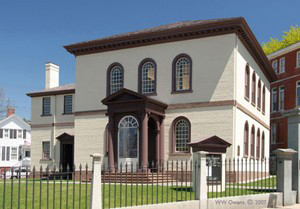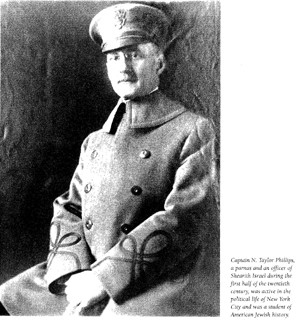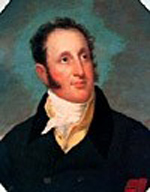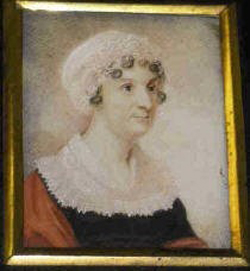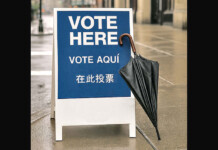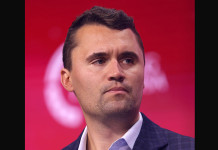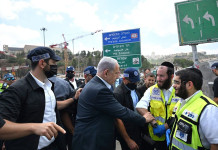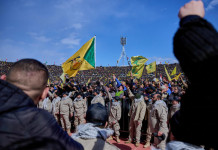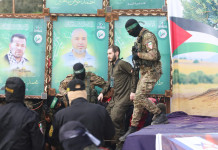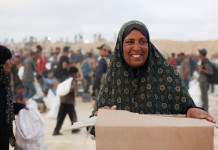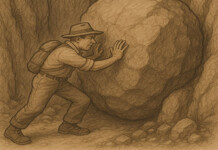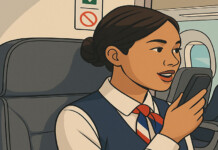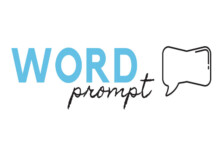Reverend Abraham de Sola: Scholar Extraordinaire
The name de Sola appears prominently in the annals of Spanish Jewish history. The de Solas may have settled in Andalusia (in southern Spain) as early as the sixth century.
A Non-Jew’s 1841 Impressions Of Shearith Israel
Lydia Maria (nee Francis) Child (February 11, 1802-Oct. 20, 1880) was educated at home, at a local "dame school" and at a nearby women's seminary. After her mother died when she was twelve, she went to live with an older sister in Maine for some years. She is little known today, but in her time she was a famous anti-slavery activist. She was also a novelist, editor, journalist and scholar. She is best remembered for her poem "Over the River and Through the Woods," which recalls her Thanksgiving visits as a child to her grandfather's home.
Dr. Simeon Abrahams: More Than A Footnote
There were Jews living during the nineteenth century who made substantial contributions to Yiddishkeit but who, unfortunately, are almost completely forgotten today. Their lives are at most a footnote in standard books dealing with American Jewish history. One such man was Dr. Simeon Abrahams, a pillar of the New York Jewish community during his relatively short life.
Chazzan Jacques Judah Lyons: Early American Congregational Leader
From 1654, when the first Jews arrived in North America, until 1840, when the first Orthodox ordained rabbi, Rav Abraham Rice, settled in Baltimore, American Jewry was led by chazzanim and baalei batim (private individuals) who had better than average Torah educations. These men did their best to fill the void in rabbinical leadership that characterized American Jewish life until the last few decades of the nineteenth century.
Jacob da Silva Solis – Advocate For Orthodox Judaism
Jacob da Silva Solis was born into London's Sephardic community on August 4, 1780. He referred to himself as Jacob S. Silva. Arriving in America on October 25, 1803, Jacob almost immediately affiliated with New York's Spanish-Portuguese Synagogue (Shearith Israel). On April 24, 1811, he married Charity Hays, daughter of a Westchester County farmer. They had seven children, the eldest born in 1813 and the youngest in 1827.
The Case Of The Charleston Synagogue Organ
In 1749 the Jews of Charleston, South Carolina established their first synagogue, Kahal Kodesh Beis Elokim (KKBE). Last month we examined the events that led some members of KKBE to establish The Reformed Society of Israelites.
The Reform Movement Comes To Charleston
Last month we traced the establishment and development of the Jewish Community in Charleston, South Carolina, and its first synagogue, Kahal Kodesh (Holy Congregation) Beth Elokim (KKBE). From its inception in 1749 the synagogue was Orthodox and followed the Sephardic ritual. (This was the case with all of the synagogues founded during colonial times.)
The Early Jewish Community Of Charleston
The English first settled at Albemarle Point in what is now South Carolina in 1670. In 1680 this settlement was moved to a peninsula between the Ashley and Cooper Rivers, and became Charles Town (named in honor King Charles II). The new location was more healthful than the original settlement, and, since it was behind the islands of a land-locked harbor, provided safety from attack. The name was changed to Charleston at the end of the War of Independence.
Colonial Jewish Businesswomen
There is a stereotype that many may have regarding women of the past - namely, that their place was in the home. But this was not necessarily the case for Jewish women during the seventeenth and eighteenth centuries. Indeed, there were some women during this period who were engaged in a variety of commercial endeavors. Things did begin to change at about the beginning of the nineteenth century, when the attitude that a woman's place is in the home became prevalent.
Building And Dedication Of The Newport Touro Synagogue
The January installment of Glimpses Into American Jewish History discussed the early Jewish settlement of Newport, Rhode Island.Even as the Newport Jewish community developed, its numbers were always small, especially compared to Jewish communities today. Indeed, despite growth during the middle part of the 18th century, there were probably never more than 100 Jews residing in Newport.
Ezra Stiles And The Jews Of Newport
The Rev. Ezra Stiles was born on November 29, 1727 in Connecticut and graduated from Yale University in 1746. He then studied theology at Yale and was ordained in 1749. After working as a tutor at Yale for a year, he began some mission work among the Indians. In 1752 he was forced to give this up due to ill health. He turned to the study of law and in 1753 took the attorney's oath. He practiced law in New Haven until 1755, whereupon he returned to the ministry, accepting the position of pastor of the Second Congregational Church in Newport, Rhode Island, serving there from 1755 until 1777.
The Early Jewish Settlement Of Newport
In 1636 Roger Williams, after having been banished from the Massachusetts Bay Colony for what were considered radical religious views, settled at the tip of Narragansett Bay. He was joined by twelve other settlers at what he named Providence Plantation, due to his belief that God had sustained him and his followers.
N. Taylor Phillips: Scion Of One Of America’s First Jewish Families
Naphtali Moses Taylor Phillips, generally known as N. Taylor Phillips, was a descendent of one of America's first Jewish families. His great-great-great grandfather, Dr. Samuel Nunes (Nunez) Ribeiro and his great-great grandmother, Zipporah were among the first group of Jews to arrive in Savannah, Georgia in 1733. Zipporah married David Mendes Machado, who served as the chazzan of Congregation Shearith Israel in New York from 1737 until his passing in 1747.
The Man Who Brought Judah Touro Back To Judaism
Last month's column sketched the life of Judah Touro (1775-1854), who became immensely wealthy after his move to New Orleans in 1802, using his fortune to support many causes and individuals.
American Jewry And The 1840 Damascus Blood Libel
Anyone familiar with Jewish history knows of the blood libels that have been used against Jews for centuries.
Jewish Education In America Circa 1870
During the nineteenth century a large number of American Jews abandoned traditional religious observance. This led to the United States being dubbed “di treifene medina” (the irreligious land).
The Jewish Chaplaincy Controversy
“The American tradition of the military chaplaincy is as old as the United States itself. Clergymen served with the armies of the individual colonies almost from the first battle of the Revolution, and provisions for the payment of chaplains were enacted by the Continental Congress as early as 1775.
Jewish Soldiers Observe Pesach During The Civil War
In the 17th, 18th and 19th centuries Jews in America did not face the level of discrimination encountered by their brothers and sisters living in other lands.
The First Jew To Live In North America
The year 2004 marked the 350th anniversary of Jewish settlement in America.
Recife – The First Jewish Community In The New World
Many people know that on September 7, 1654, twenty-three Jews arrived in New Amsterdam (renamed New York after the Dutch left).
Jews Settle In New York
In 1654 the Portuguese recaptured the city of Recife, Brazil from the Dutch. This marked the end of the vibrant Jewish community that had flourished under the Dutch beginning in 1630.
Two Founding American Jewish Fathers
"The twenty-three Jews who sailed into New Amsterdam harbor on a September day in 1654 were to found the first Jewish community in what is today the United States.
Maintaining Yiddishkeit In Colonial Times
It was not easy to maintain tradition and religious observance in the sparsely settled American colonies.
Aaron Lopez, Colonial American Merchant Prince
One cannot fully appreciate the life and accomplishments of Aaron Lopez (1731-1782) unless one is familiar with the history of the Inquisition.
Bris Mila During Colonial Times
Since the time of Avraham Aveinu, Jews have observed the mitzva of having their sons circumcised on the eighth day after birth.
Escape From The Inquisition
"In 1478 at the request of the Spanish sovereigns Ferdinand and Isabella, Pope Sixtus IV (1471-84) issued a papal bull allowing for the creation of the Spanish Inquisition.
The Jewish Settlement of Savannah, Georgia
London, in the late 1720's was overflowing with peoples of many origins.
A Haven for Jews in New York (Part I)
In 1825, more than 70 years before the First Zionist Congress was held in Basel, Switzerland, Mordechai Manuel Noah startled the world by proposing a concrete plan for the establishment of a Jewish city of refuge in North America.
A Haven For Jews In New York (Part II): The Founding Of Ararat
The previous installment of Glimpses into American Jewish History (Jewish Press, Feb. 3) dealt with the life of Mordechai Manuel Noah (1785-1851). Noah, a man with an unbelievable breadth of interests and activities, was, for many years, considered theleader of the New York Jewish community.
Rebecca (Machado) Phillips: Colonial Jewish Matriarch
Little has been written about the lives of Jewish women during colonial times. In general, historians have focused on the lives of men who were noteworthy during that era, primarily because more information is available about men who were publicly active than women who, more often than not, devoted the majority of their efforts to the home scene.








